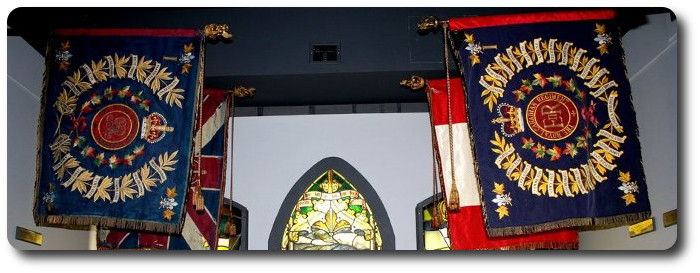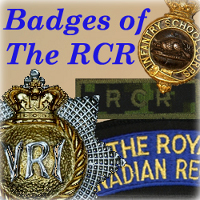
Researching The Royal Canadian Regiment
As Others See Us
The Connecting File, Volume IX, No. 2; April 1932
(We acknowledge with thanks the courtesy of our friends and allied Regiment, the Gloucesters, in sending us a copy of their very interesting Annual Report of 1929. An article on The Royal Canadian Regiment is included which we reproduce as a matter of record. The initials at the end are those of our good friend, Captain R. M. Grazebrook, O.B.E., M.C.) - Ed.
The following brief account of the services of The Royal Canadian Regiment is contributed chiefly through the kindness of the Editor of The Connecting File, who has enabled me to make use of a short history of the Regiment by Major H. T. Cock, M.C., R.C.R.
Before, however, giving their record it may be of interest to state something of the constitution and organization of the Land Forces of the Dominion of Canada.
The military forces of the country are constituted as militia, active and reserve. They are liable for service in the defence of the Dominion, and all British subjects, between the ages of 18 and 60, are liable for service in the event of a levee en masse.
The Active Militia is divided into a permanent and a non-permanent portion and consists of units of all arms raised by voluntary enlistment, normally for three years service, during which period members are liable to be called out for a month's training each year.
Whilst the non-permanent portion of the Active Militia is comprised of 9 mounted brigades and 26 infantry brigades, the permanent portion consists of two cavalry regiments and three battalions of infantry together with a proportion of the other arms. The Permanent Active Militia is continuously embodied for the purpose of providing for the care and protection of forts, etc., and to establish schools of military instruction. They train throughout the year and as officers and N.C.O's are called upon to assist in the training of the Non-Permanent Active Militia, they are required to become highly efficient in instructional work. Actually they resemble very closely the permanent staff of the Regular army attached to the Territorial units at home.
The Royal Canadian Regiment is the senior of the three permanent regiments of infantry in Canada, and up to 1919 was the only one. They are always looked to as a pattern and an example for the more newly formed regiments in the Dominion, and we, in the Gloucestershire Regiment, are naturally right in being proud of the honour of being allied with them.
The Royal Canadian Regiment was first raised on 21st December, 1883, as a unit of the newly formed Canadian Permanent force, and in view of its instructional duties was originally known as the "Infantry School Corps." It wore as a badge a beaver on a scroll, inscribed "Pro Patria" within a circle of "Infantry School Corps"; this was mounted on a silver star. The beaver and motto, which is now worn as a collar badge, signify "Work for one's country."
The Regiment was raised by companies which were stationed at Fredericton, New Brunswick; at Quebec; at Toronto; and at London, Ontario. Sometime afterwards a fifth company was formed at St. John's, Quebec. Today the companies are stationed as follows: Headquarters: Wolseley Barracks, London; "A" Company, Halifax, N.S.; "B" Company, Toronto; "C" Company, London; "D" Company, St. John's, P.Q.
In 1885 "C" Company from Toronto formed part of a mixed force of Canadian Militia to deal with the trouble which had arisen in Saskatchewan between the Government surveyors and the [Metis]. The latter had misunderstood the action of the surveyors in a certain unsettled area and had broken out into open rebellion. The force marched across the ice along the north shore of Lake Superior towards the North West, Half of "C" Company then joined a column moving on Batoche and took part in the action of Fish Creek, while the other half of the company being sent to guard stores, and to organize a base for the advance of another column, took part in the relief of Battleford, and in the action at Cut Knife Hill. Both parties took part in the pursuit of Chief Big Bear and finally remained to garrison Battleford until the end of the rebellion. For their services in the N.W. the City of Toronto presented a magnificent silver centre piece to the officers' mess and the Regiment was granted the battle honours "North West Canada, 1885" and "Saskatchewan."
This was actually the first occasion on which Canadian troops had conducted active operations and brought them to a successful conclusion without the aid of Imperial troops.
In 1892 the name of the Regiment was changed to "The Canadian Regiment of Infantry" and the following year, on the occasion of Queen Victoria's birthday, Her Majesty approved of the Regiment becoming known as "The Royal Regiment of Canadian Infantry" and granted permission for Her Imperial cypher, V.R.I. with the Imperial Crown, to be worn as a badge.
In May, 1898, part of the Regiment joined a mixed force which was sent as the Yukon Field Force to police the new goldfields in the far North West. This involved a march from their base of 430 miles over mountainous and comparatively unknown country and was accompanied with much difficulty and hardship. Part of the force was later sent to Dawson City to assist the Royal North West Mounted Police to supply guards over the gold-trains, etc. They were eventually withdrawn in 1899 and 1900, having successfully carried out their arduous services in this distant part of the Dominion.
On the outbreak of the South African War a 2nd (Special Service) Battalion was raised and sailed towards the end of 1899. On arrival at Cape Town the Battalion was immediately sent up country on the lines of communication and in February, 1900, was included in the newly formed 19th Brigade under Major General Smith-Dorrien. The Battalion took part in Lord Robert's advance on Bloemfontein and particularly distinguished itself in the seven days fighting which led to the surrender of Cronje at Paardeberg. Together with the rest of the brigade in the early hours of 27th February the R.C.R. carried out an attack astride the Modder River and were largely instrumental in the capture of the Boer position.
The Regiment then continued north, marching often on half-rations and covering during one period of 30 days 330 miles with fighting on 21 days.. After the relief of Bloemfontein the R.C.R. took part in the operations in the Transvaal and were actually the first British troops to enter Pretoria in June, 1900.
The casualties in the Regiment were the heaviest suffered by any Canadian contingent serving in South Africa and amounted to 67 killed or died and 123 wounded. For their services in the war they were granted the honours "Paardeberg" and "South Africa, 1899-1900."
The 2nd Service Battalion left South Africa in November for England where it was inspected and thanked by Queen Victoria. It arrived at Halifax in December and was disbanded.
In 1899 a 3rd (Garrison) Battalion had been raised to help garrison the Fortress at Halifax, and so relieve an Imperial battalion for service elsewhere. The 3rd Battalion was eventually disbanded in September, 1902.
In 1901, King George V, when Duke of York, presented a stand of Colours to the Regiment at Toronto during his tour of the British Empire and in 1904 a special banner was given by King Edward to commemorate the services of the Regiment in South Africa.
During the Boer War the name of the Regiment had been changed to "The Royal Canadian Regiment of Infantry," but in 1902 it was once again altered this time to its present title - "The Royal Canadian Regiment."
It was about this time also that the Regimental March, usually known as "The R.C.R. March," was first used. It is entirely original and was written by a serjeant of the Band. With its lively strain it is now a great favourite in both battalions of the Gloucestershire Regiment, and is played at the end of every programme with the regimental marches.
In 1908 part of the Royal Canadian Regiment attended the Quebec Tercentenary celebrations where, at the march past before King George, then Prince of Wales, it was ordered to proceed last. When it came to the saluting base the Prince of Wales asked what regiment it was. The general told him it was the Royal Canadian Regiment of the Permanent Corps. "But," said His Royal Highness, "should they not have marched past first?" To which the general, himself an old officer of the R. C. R. replied: "I ordered them to march past as they are doing, Sir." "Ah," said the Prince of Wales, "I see, you have kept the good wine till the end."
On the outbreak of the Great War in August, 1914, the Regiment was mobilized at Halifax, where it occupied the various forts. Being trained regular troops and the only ones available for service overseas, the Regiment was sent to Bermuda in September to relieve the Lincolnshire Regiment and were the first Canadian troops to go abroad. In August the following year they were relieved and proceeded to France. The Battalion became corps troops to the Canadian Division and in November, 1915, went into the trenches for their first tour, with the 1st Canadian Division, opposite Messines. In the beginning of 1916, the R.C.R. was one of the units in the 7th Canadian Infantry Brigade of the newly formed 3rd Canadian Division.
The first general action of the Regiment was that of the German attack in June at Hooge in the Ypres Salient, when they distinguished themselves by their steadiness under very severe hostile artillery and trench-mortar fire. The steady rifle and machine-gun fire of the Regiment was very largely responsible for the breaking up of the German efforts in this locality. On 5th June, the enemy blew up three large mines at Hooge and practically annihilated the garrison. Again the machine guns of the R.C.R. by their immediate and cool action on the Menin Road prevented the German infantry from completely overwhelming the position. It was once again a splendid example of the value of a battalion of long-service men with their amazing steadiness and fire discipline.
Between June and August numerous gallant trench raids were carried out, while in September, with the rest of the Canadian Corps, the Regiment moved south to the Somme. Here up to November they were constantly engaged in capturing and holding sectors of the enemy's line. After a particularly severe engagement at Regina Trench on October 8th though outflanked and unsupported the Battalion held on against attack after attack. The losses, however, were very heavy, and all but one officer and 81 other ranks had become casualties.
After the Somme fighting the Regiment had become so depleted that they were obliged to reorganize. Later they moved north again and took part in the almost daily raids which were undertaken to harass the enemy.
On 9th April, 1917, the Regiment was present in the battle of Vimy Ridge and captured all their objectives with comparative ease, and were successful in maintaining their position in spite of repeated counter attacks.
After serving at Hill 70 the R.C.R. moved north to the Ypres Salient and came in for the heavy fighting about Passchendaele in October. Christmas and the New Year were spent in the line in the Lens sector, and during the spring of 1918 the Regiment as part of the Canadian Corps was in the line continuously for two months.
On August 8th the Regiment took part in the great general offensive, being on the extreme right of the British line. The right leading platoon was actually interlocked with the extreme left platoon of the French Army.
Later in August the Battalion took part in the Battle of Arras and next month in the battle of Cambrai.
In the final advance the Regiment claims to have provided the first patrol to enter Mons on the 11th November. The first officer to sign the Burgomaster's book was an officer of the R.C.R. - Lieutenant King, who was in command of one of the leading patrols.
After the Armistice the Regiment advanced by easy stages into Germany, doing its share with the remainder of the Canadian Corps in the Army of Occupation.
The Regiment returned to Canada in Mach, 1919, receiving a tremendous reception from the citizens of Halifax, Nova Scotia.
For the past ten years they have undertaken again their instructional work with the Non-Permanent Active Militia, and today its four companies are stationed as recorded in the beginning of this brief account of The Royal Canadian Regiment.
R.M.G.


